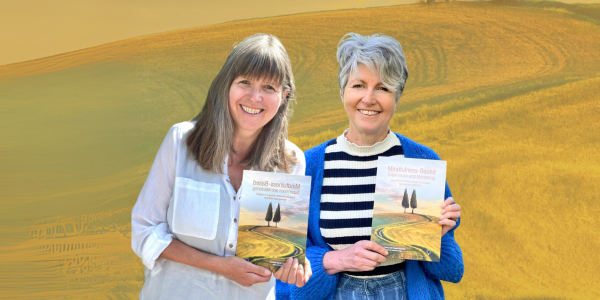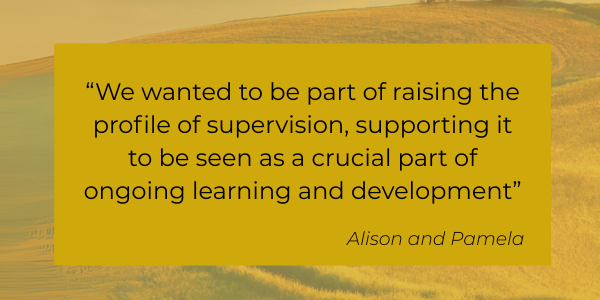
Mindfulness-Based Supervision and Mentoring: Using an Embodied Dialogue to Support Learning and Reflection is now available!
This new book by Alison Evans and Pamela Duckerin describes a unique mindfulness-based approach to supervision that is both framework and practice-driven (MBS). It outlines the theoretical and pedagogical background, the details of the framework’s elements, and various ways of applying it. The book utilises metaphors, stories, examples, visual representations, reflection questions, spaces to practice and downloadable resources. The book pulls together work on MBS spanning over 12 years with many contributors over that period of time.
Alison and Pamela answer some questions about mindfulness-based supervision and the book, below. In the same collaborative spirit as the writing process, they joined each other in conversation to ponder their journey.

How did each of you come to focus on supervision in your mindfulness work?
We both experienced how supervision was a vital part of our learning to teach mindfulness and were fortunate to receive excellent supervision. It became the backbone of our support and development and has continued to do so.
AE: From that personal experience of receiving supervision, I developed my interest as I moved into training others to teach in the context of postgraduate study with the University of Exeter. Supervision was an essential part of training, and it got me reflecting on what the mindfulness aspect of supervision was, how to support teachers to move into being supervisors, how supervision could help trainees in their learning etc. I continued to explore through my studies for my MSc and Doctorate.
PD: My first interest in supervision was from my experience as a clinician working in healthcare. I have always valued clinical supervision, and from early in my career, I was keen to develop my skills as a clinical supervisor. It felt very natural within my mindfulness-based work to move into the role of supervisor and to continue to cultivate skills and experience within mindfulness-based supervision.
You have both been instrumental in developing supervision training through the Mindfulness Network. How does this book reflect that work?
AE & PD: There is so much from that work in this book. We realised during these trainings how helpful it is for trainees to have a combination of frameworks and structures, a theoretical and pedagogical background, practice of supervision and links to mindfulness practice – people need all of these aspects to support their development. In the trainings, we learn from participants – they make us think, reflect, and we discuss together. As we teach, we go through the experiential learning process, testing out ideas, practices, and exercises. A few years ago, we could see that there was more than we could cover in the training, a lot to say – enough to fill a book!
What sets mindfulness-based supervision apart from other forms of supervision?
In the book, we use the weaving metaphor of the warp and weft. This metaphor distinguishes between the consistent threads of the MBS framework- the warp, and the threads that can be adjusted as needed- the weft. The warp, in particular, is what makes it mindfulness-based. It consists of three key threads: the mindful container, the mutual relational inquiry, and the use of pauses and space. These are the vertical threads that ensure supervision is steeped in a mindfulness-based approach. Mindfulness practice is the foundation for this approach, and we see MBS as a form of practice.
 What inspired you to write the book at this point in time, and what do you hope it will offer to the field?
What inspired you to write the book at this point in time, and what do you hope it will offer to the field?
We knew from our supervision colleagues in the Mindfulness Network and our supervision trainees that there was passion and interest. There wasn’t a book about MBS. We could see that in many ways, the field and professional associations are looking to name and maintain integrity and clarity. Supervision was featured within that mix of what constitutes good practice, and we hope to make that process transparent and maintain quality and consistency. We wanted to be part of raising the profile of supervision, supporting it to be seen as a crucial part of ongoing learning and development.
Throughout the process of creating this book, we have had changes in the field in mind and hope to reflect key themes and how MBS supports the expanding and diversification currently happening. We also wanted to ensure that the MBS framework is flexible enough to support mindfulness practitioners working in varied cultures and settings. While it began its life within MBSR and MBCT teaching, we see its usefulness as much wider in a range of mindfulness-based supervisory and mentoring relationships.
If readers could take away just one insight or encouragement from this book, whether they are new to supervision or experienced in the field, what would you most want that to be?
In many ways, we wouldn’t want to prescribe what people take away. We hope the book starts the conversation and reflection process. We hope readers will see what resonates with them and what fits, use it as a foundation, and then find out for themselves what insights they might take forward into their supervisory work.
And if we were to settle on one thing we would wish people to take away, it would be how our mindfulness-based work can be significantly enhanced by embodied dialogue, which supports learning and reflection. This is why we arrived at these carefully chosen words for our book’s subtitle.
 Watch the replay of our conversation with Ted Meissner at the book launch on Tuesday, 22 July.
Watch the replay of our conversation with Ted Meissner at the book launch on Tuesday, 22 July.




